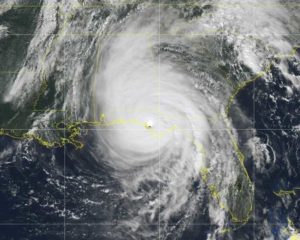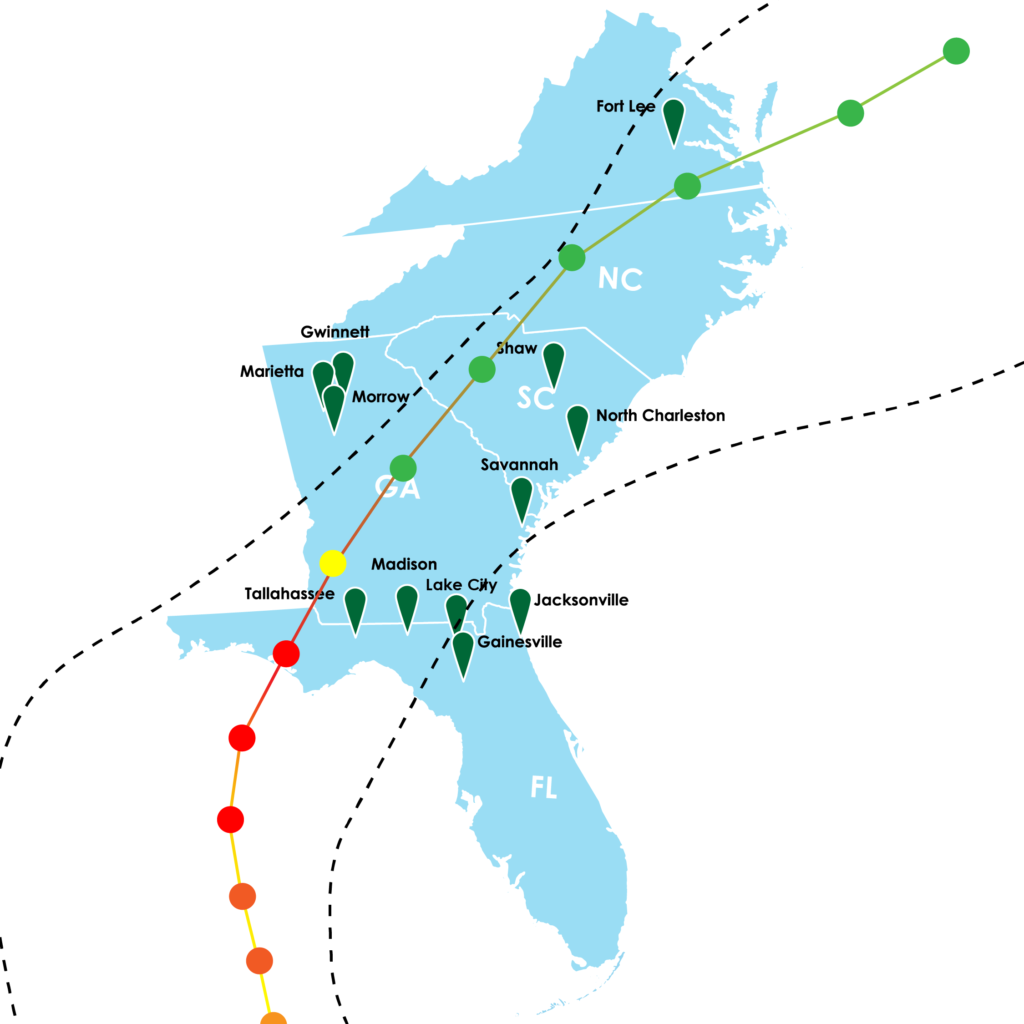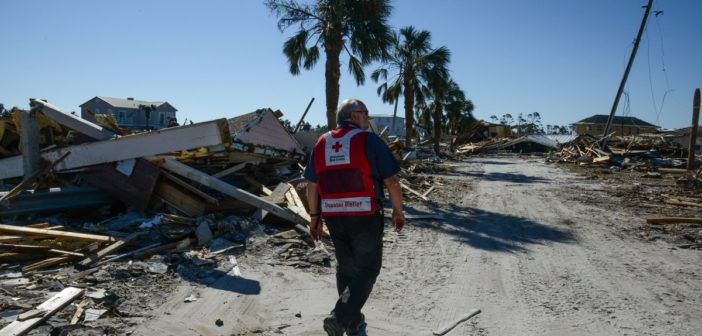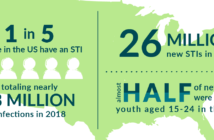Hurricane Michael devastated the states of Florida, Georgia, North Carolina and Virginia. The hurricane made landfall Oct. 10 near Mexico Beach, Florida, and resulted in more than one million without power. The hurricane also resulted in the deaths of at least 32 people, according to CNN.
The hurricane strengthened to a category 4 before making landfall. As a result of the impending hurricane, numerous of the Centers’ classes were canceled and offices were closed for a portion of the week of Oct. 10.
Michael hit just weeks after Hurricane Florence devastated the South East of the United States. Some Centers, which were affected by Hurricane Florence, were also affected by Hurricane Michael, such as the North Charleston Center. Kai Campbell, the director of the North Charleston Center, commented on students’ and faculty’s anticipation of the hurricane and what the Center did to prepare.
“Everyone was concerned; mainly due to the fact that we still had some flooding issues from Hurricane Florence two weeks prior,” said Campbell. “[We] canceled classes and stayed in constant communication with leadership from main campus.”

Hurricane Michael made landfall in Florida but continued its paths throughout the inner Southeastern United States. Credit: @JiyoNation
Along with staying in constant communication with the administration of University Campus, the Center was also able to stay in contact with students and faculty during and after the storm through e-mails, phone calls and REMIND, which is a communication tool that helps teachers reach students and other members of the community.
“We communicated with them as the hurricane was approaching. We checked on the students after the hurricane as well to ensure everyone was safe,” said Campbell.
Campbell also mentioned that there was minor damage to the surrounding areas, such as downed tree limbs down and inoperable traffic lights surrounding the center.
Campbell added that now the Center’s top priority is “ensuring all students and faculty are safe and get any support they need (personally and academically) as we begin the last term of 2018.”
Another Center that closed was the Tallahassee Education Center. The director of the Tallahassee Education Center, Elizabeth Heron, commented on the atmosphere of the community when the hurricane was announced to be heading their way.
“Most people were anxious. On Monday, it was a tropical storm which reminded many of Hermine in 2016 where we lost power for a week,” said Heron. “But when the storm strengthened up to a category 4, many were in fear. Most of Tallahassee west to Panama City closed effective Tuesday. If people evacuated, they needed to on Tuesday because Michael was arriving Wednesday. Many people did not evacuate, instead, preparing and hunkering down for Michael; grocery stores, hardware stores, Walmart, Target, gas stations, etc. were non-stop busy and low on supplies.”
The Tallahassee Education Center was open Monday, Oct. 8, but had to close for the rest of the week, with the hurricane hitting Tallahassee on Wednesday, Oct. 10. Heron mentioned what the Centers did to prepare for the hurricane.
“The storm went from a tropical storm to category 4 in 40 hours. There wasn’t much preparation time,” stated Heron. “We had Monday to prepare, so we secured exterior signage on campus, covered and elevated equipment with tarps, unplugged electrical equipment, sandbagged the exterior doors and prayed.”
Although the Center faced no damage, there were many surrounding areas that were affected by the storm. According to Heron, there were thousands of downed trees and most areas of Tallahassee were without power for four to six days. As of Oct. 19, about 50 percent of those in the surrounding counties remained without power and many businesses remained closed in those communities. Also, some of the Center’s students experienced some damage due to the storm.
“One student had severe damage to her home and needs to relocate; another had a tree fall on his mother’s car. We are waiting to hear how we can help,” said Heron. “The student with severe damage dropped FA2 classes to focus on finding a home and her job. Several students were blocked by trees and debris and weren’t able to leave their neighborhoods. Some students with no power also didn’t have water.”
The Center’s priority during the storm was ensuring the students’ and faculty’s safety. Heron commented on how the Center stayed in contact with the students, faculty and staff to relay information to ensure that everyone was safe. She added that there was some difficulty getting in touch with some of the students or faculty who faced power outages.
“Communication was sent from WorldWide and we posted on Facebook. Students were able to contact the support center while we were closed. [There was] some difficulty contacting students that are still without power, internet or cell coverage this week, but we’ve made contact with the majority,” said Heron. “After the hurricane, we reached out to students and faculty to ensure they were safe and able to come back.”
Those students that were affected came by the Center to log into class and submit work. Tallahassee Education Center made additional efforts before and after the hurricane to accommodate students with class work.

Hurricane Michael resulted in the closure of more than ten Saint Leo Centers during the week of Oct. 10. Credit: Christian Silva
“Email communication was sent to students and faculty letting them know about Michael, so they could prepare or evacuate. Since it was finals week, we made accommodations for students to take finals before/after since classes were canceled,” said Heron.
The upper leadership at Saint Leo was also concerned with the students’ academics as indicated through a notice sent to the Saint Leo Community Thursday, Oct. 11, requesting that accommodations are made for students.
“With the approach of Hurricane Michael, we ask that all faculty provide extreme flexibility allowing for extensions on assignments and exams and allowing for excused absences so that both online and center students may make necessary plans to prepare for the hurricane or evacuate as needed,” said acting Vice President for Academic Affairs Dr. Mary Spoto.
Saint Leo’s administration also showed concern for the persons’ safety. Dr. Senese addressed a letter to colleagues, students and alumni, who were in the path of Hurricane Michael. The email was sent Oct. 10 and he made known that the Saint Leo University community has them in their thoughts and prayers.
“We are praying for you, for your safety and for the protection of you and yours against Hurricane Michael. We pray that you and your family, friends and neighbors remain safe. Just as with Hurricane Florence, we should draw from the words of Saint Benedict, “And let them first pray together, that so they may associate in peace.” We pray with you for rapid passage of the storm and a return to peaceful weather, as well as a speedy recovery from any aftermath,” said Dr. Senese.
Luckily, many Centers faced minimal damage, such as Lake City Education Center and Madison Education Centers, which are both located in Florida. The director of these Centers, Jessica Markham, mentioned the impact of the hurricane on these two Centers.
“Lake City was closed due to the hurricane, but we ended up between the rain bands and had no damage and no power outages. We didn’t have any students directly impacted,” said Markham. “Madison also closed, and we had two students that were without power for two days, but nothing major.”
The Jacksonville and Mayport locations also faced minimal damage. According to Jessica Starkey, the director of the Jacksonville Center and the Mayport office, mentioned that the only impact of the Center was the cancelation of evening classes Wednesday, Oct. 10 due to concerns of high winds and heavy rain.
“The Jacksonville and Mayport locations were lucky. The effects of Michael were minimal, no damage was reported, and most severe weather evaded out areas,” said Starkey.
A similar situation was faced with the Morrow Center, according to Michelle Myrick-Simmons, the director of this Center, which is located in Georgia.
“We did shut down the center to be careful of our students traveling to class because we have night classes. We did not receive any notifications that any of our students or staff were affected,” said Myrick-Simmons. “We re-opened the next day with no issues.”
The other Centers in Georgia experienced no impact either, according to Atlanta Regional Director Mary Estes. She mentioned that the Atlanta Centers, Marietta, Gwinnett and Morrow, sustained no flood or wind damage and the power did not go out, and she mentioned that they were fortunate.
“We did close the centers in Atlanta at 2 p.m. on Wednesday, Oct. 3 and remained closed until noon the following day. That decision was in response to the hazardous weather-related travel conditions predicted for middle and north Georgia. It was a good decision by Dr. Melanie Storms,” said Estes. “Many of our staff, students and faculty have long commutes on a regular clear day. We were all thankful to have been safely at home with our families and not in a dangerous commute during Michael’s inconvenient and unpredictable tour of Georgia.”





